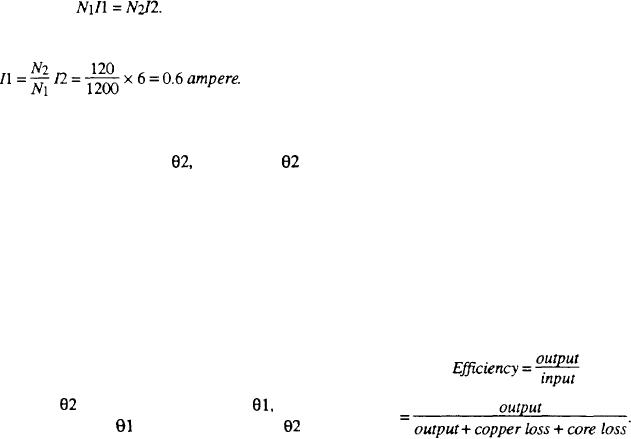
output. For example, a transformer having a full-load
is low and the primary current is limited principally by
rating of 100 kVA can supply a 100-kW load at a unity
the counter emf in the winding, the transformer primary
power factor, but only an 80-kW load at a lagging power
current increases when the counter emf in the primary
factor of 80 percent.
is reduced.
Many transformers are rated in terms of the kVA
The increase in primary current continues until the
load that they can safely carry continuously without
primary ampere-turns are equal to the secondary
exceeding a temperature rise of 80C when maintaining
ampere-turns, neglecting losses. For example, in the
rated secondary voltage at rated frequency and when
transformer being considered, the magnetizing current,
operating with an ambient (surrounding atmosphere)
Ia, is assumed to be negligible in comparison with the
temperature of 40C. The actual temperature rise of any
total primary current, I1 + Ia, under load conditions
part of the transformers the difference between the total
because Ia is small in relation to I1 and lags it by an angle
temperature of that part and the temperature of the
of 60. Hence, the primary and secondary ampere-turns
surrounding air.
are equal and opposite; that is,
It is possible to operate transformers on a higher
frequency than that for which they are designed, but it
In this example,
is not permissible to operate them at more than 10
percent below their rated frequency because they will
overheat. The exciting current in the primary varies
directly with the applied voltage and, like any
impedance containing inductive reactance, the exciting
Neglecting losses, the power delivered to the primary is
current varies inversely with the frequency. Thus, at
equal to the power supplied b the secondary to the load.
reduced frequency, the exciting current becomes
If the load power is P2 = E21 2 cos
and cosine
excessively large, and the accompanying heating may
2
equals cosine 30 (0.866), then P = 120 x 6 x 0.866=
damage the insulation and the windings.
624 watts.
The load component of primary current, 11,
EFFICIENCY
increases with secondary load and maintains the
transformer core flux at nearly its initial value. This
The efficiency of a transformer is the ratio of the
action enables the transformer primary to take power
output power at the secondary terminals to the input
from the source in proportion to the load demand, and
power at the primary terminals. It is also equal to the
to maintain the terminal voltage approximately
ratio of the output to the output plus losses. That is,
constant. The lagging power-factor load vectors are
shown in figure 4-31, view D. Note that the load power
factor is transferred through the transformer to the
primary and that
is approximately equal to
the
is slightly larger than
only difference being that
because of the presence of the exciting current, which
The ordinary power transformer has an efficiency
flows in the primary winding but not in the secondary.
of 97 to 99 percent. The losses are due to the copper
The copper loss of a transformer varies as the square
losses in both windings and the hysteresis and
of the load current; whereas the core loss depends on the
eddy-current losses in the iron core.
terminal voltage applied to the primary and on the
The copper losses vary as the square of the current
frequency of operation. The core loss of a
in the windings and as the winding resistance. In the
constant-potential transformer is constant from no load
transformer being considered, if the primary has l,200
to full load because the frequency is constant and the
turns of number 23 copper wire, having a length of 1,320
effective values of the applied voltage, exciting current,
feet, the resistance of the primary winding is 26.9 ohms.
and flux density are constant.
If the load current in the primary is 0.5 ampere, the
primary copper loss is (0.5)2 x 26.9 = 6.725 watts.
If the load supplied by a transformer has a unity
power factor, the kilowatt (true power) output is the
Similarly, if the secondary winding contains 120
turns of number 13 copper wire, having a length
same as the kilovolt-ampere (apparent power) output.
If the load has a lagging power factor, the kilowatt
of approximately 132 feet, the secondary resistance will
output is proportionally less than the kilovolt-ampere
be 0.269 ohm. The secondary copper loss is I2R2, or
3-28

